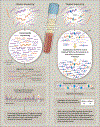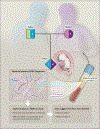Sequencing of Circulating Cell-free DNA during Pregnancy
- PMID: 30067923
- PMCID: PMC10123508
- DOI: 10.1056/NEJMra1705345
Sequencing of Circulating Cell-free DNA during Pregnancy
Abstract
Sequence analysis of cell-free DNA (cfDNA) fragments that circulate in the blood of pregnant women, along with the translation of this method into screening for fetal chromosome abnormalities, is a success story of modern genomic medicine. In less than a decade, prenatal cfDNA testing has gone from small, proof-of-principle studies to a global transformation of prenatal care. As of late 2017, a total of 4 million to 6 million pregnant women had had DNA from their plasma analyzed to screen for fetal aneuploidy. The exponential growth of the test has been a function of the role of the biotechnology industry in its development and marketing. Here we review what has been learned from the wide-scale implementation of this testing, how it has changed prenatal clinical care, and what ethical concerns have arisen, and we speculate about what lies ahead.
Figures


Comment in
-
Sequencing of Circulating Cell-free DNA during Pregnancy.N Engl J Med. 2018 Dec 6;379(23):2282. doi: 10.1056/NEJMc1812266. N Engl J Med. 2018. PMID: 30526337 No abstract available.
References
-
- Green ED, Rubin EM, Olson MV. The future of DNA sequencing. Nature 2017; 550:1 79–81. - PubMed
-
- Lo YM, Corbetta N, Chamberlain PF, et al. Presence of fetal DNA in maternal plasma and serum. Lancet 1997; 350: 485–7. - PubMed
-
- Rava RP, Srinivasan A, Sehnert AJ, Bianchi DW. Circulating fetal cell-free DNA fractions differ in autosomal aneuploidies and monosomy X. Clin Chem 2014; 60: 243–50. - PubMed
-
- Canick JA, Palomaki GE, Kloza EM, Lambert-Messerlian GM, Haddow JE. The impact of maternal plasma DNA fetal fraction on next generation sequencing tests for common fetal aneuploidies. Prenat Diagn 2013; 33: 667–74. - PubMed
Publication types
MeSH terms
Substances
Grants and funding
LinkOut - more resources
Full Text Sources
Other Literature Sources
Medical
Research Materials
